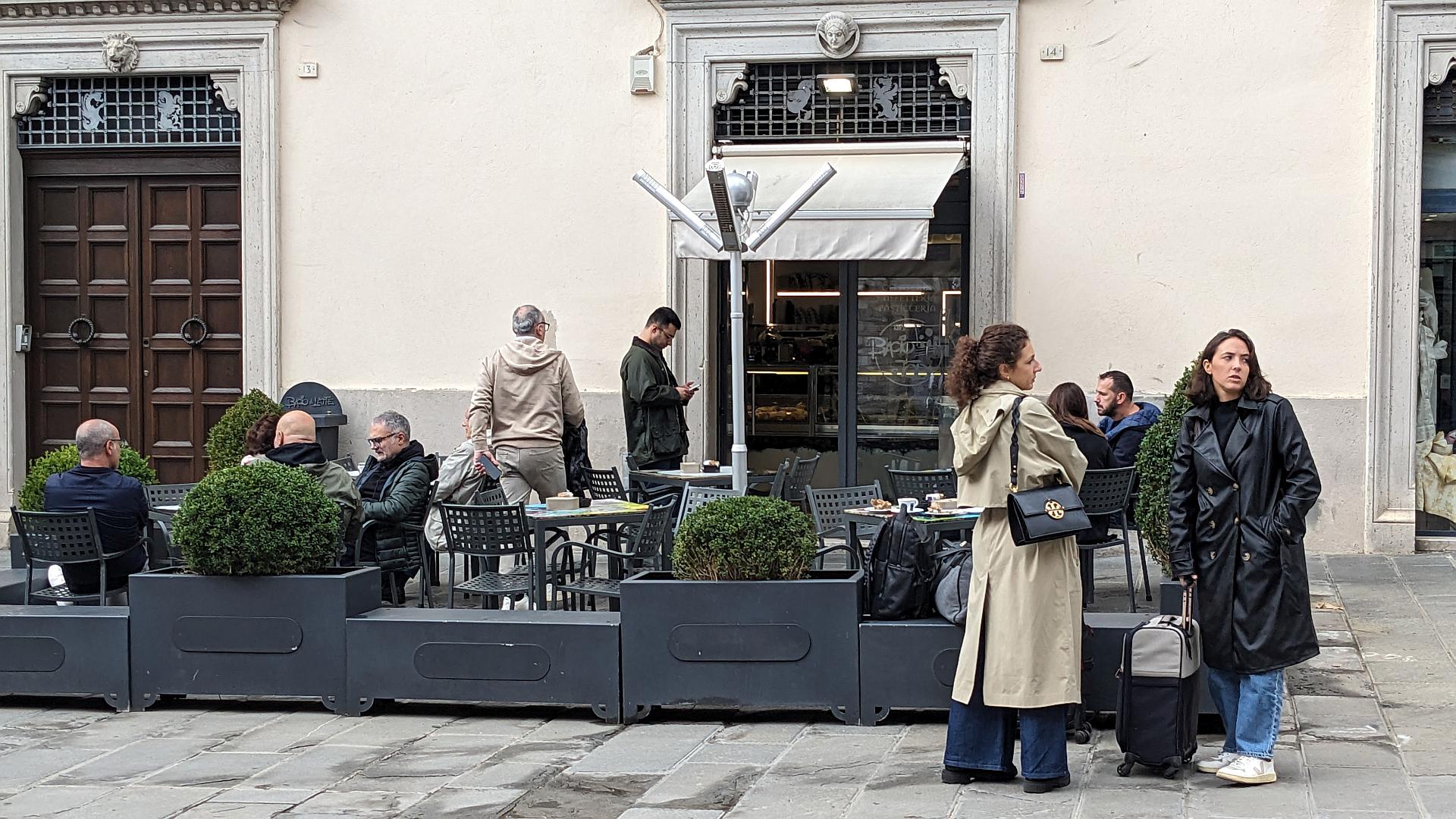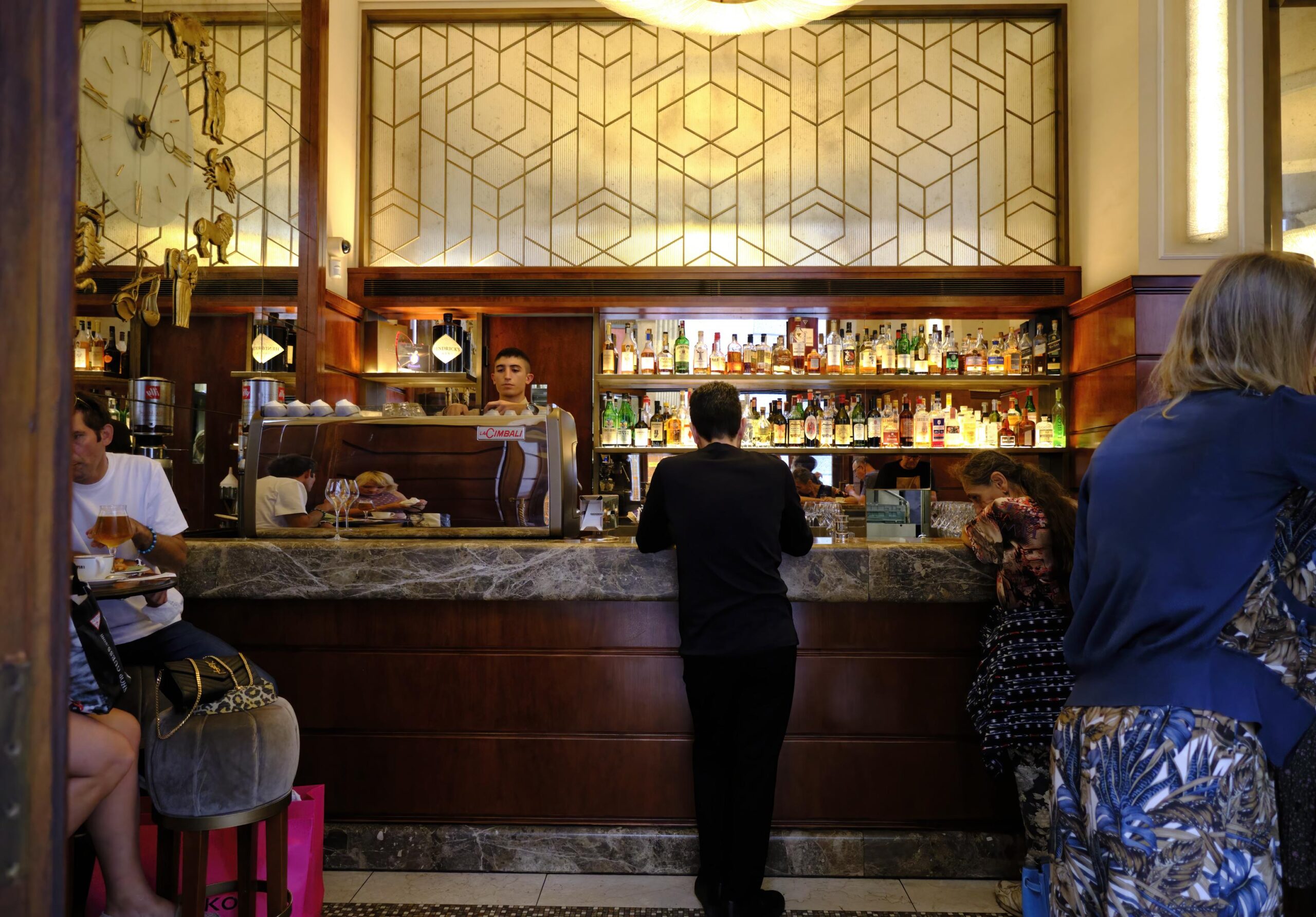What are Italian bars? Well, that depends on the time of day. In the morning, they will be cafés. For many people, breakfast is an espresso and a cornetto (croissant) or other pastry consumed quickly while standing at the counter.

Perhaps you might run into a neighbour and briefly agree on what a terrible job the comune is doing managing the traffic, or the rubbish collection, before hurrying on your way.


A bit later, people with more time on their hands will sit at a table and spend some time over a coffee and the newspaper. They might have paid only €1.50 for their espresso, but no-one will object to how long they spend there.


It is now, in the mornings, that it is still acceptable to drink milky coffees. Note to Americans and Australians: if you ask for a “latte”, you have ordered a glass of milk, and if you are not in a tourist area, that is probably what you will get. A milky coffee is a caffè latte or of course, a cappuccino. Note that the stress on caffè is on the last syllable, and the double consonant needs to be emphasised. Here is an article on how to order a coffee in Italy.

Later in the morning (around 11am, but it varies with region and season) consuming milky coffee ceases to be appropriate and becomes a threat to the digestion that no Italian would risk. But at that time (again, it varies) alcoholic drinks start to appear, and there will be a transitional period when the two coexist, although of course a short black espresso can be had at any time of day. I believe, although I have not researched it personally, that a caffè corretto (espresso with a dash of spirits) is considered acceptable at any time, no matter how early.
When entering a bar for the first time, it pays to hang back and observe. Do they do table service, or does one order at the counter? Do you pay beforehand, or when your order arrives, or when you actually leave? This can be complicated – if you pay first, you will need to know what you want beforehand, and when the bar is also a pasticceria (pastry bakery), the choice can be a bit overwhelming.

It used to be common for there to be an extra charge if you had your coffee at a table rather than standing at the counter. We don’t notice this so much any more, but don’t be surprised if you encounter it.


At around 1.30pm, some bars become trattorie and start serving meals, then in late afternoon they will revert to serving aperitivi. It is common to serve snacks with drinks at this time of day, which may or may not be an extra cost. The snacks might be nothing more than a bowl of potato crisps, but some of these snacks are so generous as to have led to the coining of a portmanteau word – apericena – from aperitivo and cena (dinner), meaning something generous enough to serve as a light meal. Some places even offer an apericena buffet. Useful if you have had a big lunch and don’t feel like you could fit much more in.


In the evening, bars turn into something even more magical. How late do bars stay open? Very late, and sometimes even all night. This latter is something which we understand started in Naples, but which you sometimes see further north. After a night on the town, rather than get a kebab as people in England or Australia might, your Italian night owl might fancy a coffee and sweet pastry. Since many bars are also pasticcerie, the staff would be starting work on the baking very early themselves, so some stay open all night. Late-night revellers might find themselves rubbing shoulders with council garbage collectors about to start the early shift. Look for signs saying cornetti di notte.

Bars change with the seasons, too. On a cold foggy winter morning, a bar throws a shaft of yellow light into the street, with the promise of a warm and cheerful refuge within. The only people who might sit outside are smokers, who now (thank goodness) may not light up indoors. Then, in March or April, those bars with outside tables which catch the sun might see a few hardy souls (still warmly wrapped up) venturing outside.

When summer arrives, those bars that can spread gloriously outwards into the street, some located on the most beautiful piazzas in the country. By August, the aim is to find shade rather than sun.

The smaller neighbourhood bars are absolutely part of their local community, a bit like maybe a village pub might be in England. All the regulars know each other and the barista will know how they like their coffee. But if you actually live in a place and want to be accepted there, then be aware that there is an element of reciprocal obligation – you are expected to be faithful to your bar di fiducia. You might just get away with having one bar for your morning coffee and another for your afternoon gelato, but to flit between multiple bars is just not done (non si fa) – a serious admonishment in a society of unwritten rules like Italy.

Italian bars vary considerably on the scale of pretentiousness. At the top end there are places like Florian’s in Venice, Rosati in Rome, or Baratti e Milano in Turin, where the waiters wear uniforms and a glass of prosecco will cost you substantially more than a whole bottle of the same stuff would in a supermarket.




At the other end of the scale are humble little places that are only known in the immediate neighbourhood. But do not be fooled – even the little places are very serious indeed about the effect they are trying to create, and the care that should go into presenting the place.


Here’s a useful tip for visitors: bars in Italy are not supposed to restrict use of their toilets only to customers; any passer-by should be able to use the facilities. This is a rule that is often broken in tourist cities like Rome, either blatantly or on the pretext that the toilet is fuori servizio, but nonetheless it is worth knowing.
A final thought – bars are often busy places, so it can be quite easy to grab some candid photographs in them without being noticed. But every now and then you are going to get busted…

